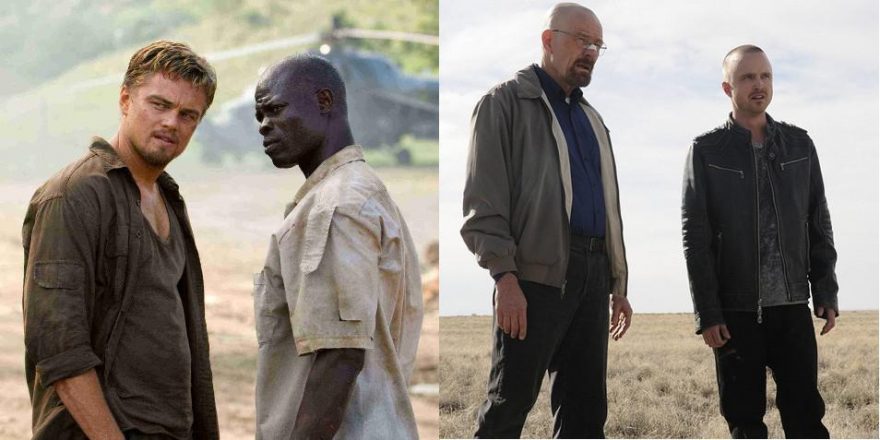This is an abstract for an academic paper to be published in the Fall 2019 edition of Black Future Lies, a media studies and social sciences journal focused on the scholarship of spiritualist hypno-media, cultural fissures and fractals, story crimes, and the social dynamics of cut, copy and paste neurobiological miasmas.
Cinema history is rife with white angels. The white angel (also known as the white savior) is an archetypal character trope. They are white men and women, most often the central character in a film or television show. They are usually thrust into a situation in which they are surrounded by characters of color. These characters of color are often oppressed or victimized by an antagonist or group of antagonists. These antagonists take many forms: sometimes they are individuals (Avatar), other times they are simply systems of oppression (Dangerous Minds, The Blind Side), occasionally they are other people of color who have been mobilized by systems of oppression to enact violence against their own (Tears of the Sun).
The white angel’s main narrative function is to rescue the aforementioned people of color (from now on I will call them the “melanated victims”) from the antagonists who imperil them. Extra points are earned if the white saviors sacrifice or martyr themselves in the process or endure a catharsis during which they mature spiritually, emotionally, or culturally. The white angel must be: brave, thin, smart, sexually attractive according to Eurocentric standards of beauty, empathetic, honest, and more capable of saving the melanated victims than they are of saving themselves. Thus, the most important narrative function of the white angel is to justify their own existence through performing an act of communal redemption that, due to the ineptitude and weakness of the melanated victims, only they could perform.
The white angel’s sociological cause and/or function is yet to be known. This paper puts forth several hypotheses as to why the archetype of the white angel has been so consistently deployed in cinema history and why the trope is uniquely popular in the medium of feature films and TV shows given that white angels show up far less often in literature, painting, sculpture, photography, theater and other storytelling media.
Briefly, one of these hypotheses for the cause:
Feature filmmaking is a harrowing, resource-intensive endeavor and the white men who control almost all of the feature-filmmaking industries find it difficult to expend the energy necessary to make a feature film that does not include their avatar, a character that represents their subjective perspective. Thus, when they are attracted to a story that centralizes melanated victims, they are compelled to (consciously or subconsciously) include themselves. Most often this means portraying “themselves” as heroic, brave, self-effacing, conflicted, but ultimately redemptive and siding with “the oppressed” to fight “the oppressors.” In the paper, we posit that this amounts to a psychosis. A type of psychotic break that is the symptom of a yet-to-be-named mental illness. This unnamed mental illness is a dissociative disorder that constructs a fantastical alternate dimension in the mind of the afflicted white man. This alternate universe is one that differs / disassociates wildly from the contemporary world and the white supremacy that exists within it. This alternate dimension’s main point of departure from the “real” world is that brave, thin, smart, empathetic, effective, competent white angels exist at all.
Briefly one of these hypotheses for the function:
Whiteness is not an ethnicity; it does not bear out many significant genetic similarities between those who use it to identify themselves. Whiteness is a construct, a tool of white supremacy to congeal economic, political and social power among people that otherwise have nothing in common, no language, no creed, no culture, only a color (kind of). American whiteness is a very recent construct that has been intentionally perpetuated to create cultural solidarity and sustain economic power. In order to craft this solidarity, someone uses fictional stories, most often origin stories that riff on the fact-ish-fictive myths of European history in the Americas: the pilgrims chumming it up with the Iroquois, John Smith falling in love with Pocahontas, Columbus landing in America … at all, LBJ having the dream on which the fall of Jim Crow was founded, to name a few. Given this sustained effort to retain social and thus economic power, the function of the persistence of the white angel archetype in film is to mythologize and romanticize whiteness throughout a history in which it had no (heroic) part.
This mythologizing is a broad stroke designed to help sustain power by providing a sort of communal psychotherapeutic experience for white people in which their worst fears about the sins of their ancestors can be washed away by the myths presented as fact-ish fictions of their white angel avatars. The trope is a bedtime story designed to rock the white masses to sleep with a smile on their faces and peace in their hearts, knowing that someone who looked like them, at the end of the day, did the right thing, and they too … are doing the right thing. It is an aspirational fiction that somehow does not self-perpetuate. White angel movies do not model angelic behavior for the white masses; if they do, this modeling has yet to produce more real-life white angels or at least a critical mass of them (unless Bill Gates decided to start his foundation after seeing Blood Diamond).
The paper delves deep into these and many more hypotheses about the cause and function of the white angel.
The white angel has been met with much criticism from audiences, critics, and black filmmakers (interestingly, but not surprisingly, white filmmakers have remained silent on the issue). This blowback reached its nadir during the release of Avatar, ironically the most profitable film ever made and at a budget of $237,000,000, the 10th most expensive film ever made. The outpouring of disapproval has entrenched itself into the film industry’s cultural zeitgeist and this paper hypothesizes that the result of this has been a sustained uptick in the use of the archetype of the white devil.
At present, cinema is rife with white devils. The white devil (also known as the white demon, and the anti-hero) is an archetypal character trope. White devils are white men and women, most often the central character in a film or television show. They are usually thrust into a situation in which they are surrounded by other white characters who do not possess their preternatural level of genius or skill. These surrounding white characters are usually seen as a foil to the white devil’s inherent genius. The wrinkle is that the white devil is his or her own antagonist. Often some visualization of their Jungian shadow consistently pervades their life and relationships. This shadow self is usually morally depraved, solipsistic, violent, destructive and power hungry. That said, the power that this shadow generates is a source for the white devil’s exceptional technical genius. These genius skills are mostly technical in the broadest sense of the word; see Walter White, the chemist, Dr. House, the healer, Tony Soprano, the manager / negotiator, etc.
The white devil’s narrative function is to win in the battle against his or her shadow self and make sure the dark energy that their shadow generates is used “for good.” Often this manifests itself in a narrative arc that sees the white devil simultaneously succumb to the evil inherent in indulging one’s shadow and benefiting from the success generated by the shadow’s fueling of the white devil’s technical genius. These archetypal white devil narratives often end in a way that resolves the consequences of both the indulging of the shadow and the use of the genius; indulging the shadow most often ends in the death or subjugation of the white devil, and deploying the genius often ends in some material gain for the white devil and or the people around them. The white devil is almost always afforded an “origin story” or an explanation of how a past trauma – for example, an absent or abusive father (Nucky Thompson), war (Don Draper), a business deal gone wrong (Walter White) – motivated both the inflation and power of their shadow self and thus the unending obsessive pursuit of their technical genius.
The white devil’s sociological cause and function is yet to be known. This paper puts forth several hypotheses as to why the archetype of the white devil has been so consistently deployed in cinema and TV recently and why the trope is uniquely popular in the medium of television dramas. The hypotheses also attempt to specifically address the relative absence of black devils, or Asian devils, in film and TV.
Briefly, one of these hypotheses for the cause:
The white angel (savior) has consistently been met with disapproval from audiences and critics alike. The recent rise of social media as a tool for mass popular dissent has predicted a sustained cypher in which a white angel’s appearance is met with an almost immediate backlash – a backlash that has in recent years been more immediate and universally accessible. The paper posits that this backlash has resulted in a “come to Jesus” moment for white male writers, directors and producers which has led them to re-evaluate the characterization of the angelic avatars that represent their perspective. The cultural zeitgeist has moved these characterizations toward the archetype of the white devil who, unlike the white angel, has no narrative purpose but to save themselves and is most often unsuccessful in this endeavor. This new self-characterization is a crude visualization of the oft-named pathology “white guilt.” It is what these white men feel like they can do to right the dishonest legacy of the white angel archetype. The paper posits that the popularity of the white devil is simply a symptom of a white guilt that has been awoken and prodded by the popular dissent to the archetype of the white angel. This is ironic because the dissent to the white angel consistently articulated that the solution necessary to remedy this sustained effort at mythologizing white people as saviors throughout history was to decentralize and erase white characters from the stories of melanated victims altogether. Instead the response of the white men responsible for the movies was to recharacterize the archetype, bucking any inclination to enact a real solution to the actual problem. That solution being decentralization of white characters, at its most Kumbaya iteration, and their erasure, at its most confrontational yet effective iteration.
Briefly one of these hypotheses for the sociological function of the white devil:
Feature films and television shows are very potent tools for the perpetuation and sustenance of white supremacy. D.W. Griffith’s The Birth of a Nation was both a profound technical innovation and a mythological propaganda film specifically designed to perpetuate the myths of Black male rabidity / ferality, white female sexual fragility, and white male social and sexual domination. The white devil archetype in contemporary film and TV functions as yet another display of white male dominance and social power by framing the Jungian shadow as a source of white-guy technical genius, bro-ish psycho-sexual domination, and white cultural / social centrality. Its social function is to peacock, to put on display a shadow-fueled virility and acumen. This peacocking is designed to scare the melanated masses into a self image of subordination and moral authority, but social inferiority. This is the moment when the government marches the army and their tanks and their regalia through the streets; it’s a ceremonial show of force. The desired effect is for the melanated masses to hesitate before challenging white supremacy, the hope is that in any moment of resistance no matter how big or small, they will remember that the white person or institution they are resisting has a devil inside them, an amoral devil that will not concede defeat under any circumstance.
The paper thus establishes the link between the phenomena of the white angel and white devil. It delves deep into several hypotheses that explain how and why these archetypes persist and conducts a thorough examination of their effect on contemporary American race relations. The paper also puts forth a comprehensive theory of how the archetypes of white devil and white angel help to sustain the system of white supremacy. The paper concludes with proposed solutions on how to impede the popularity of these archetypes and how to use mass media – namely feature films and TV shows – to begin to dismantle white supremacy.
—-//—-
I decided to write the above abstract for a paper I want to write at some point when I’m old and gray and smart and know all the words.
If you are a filmmaker reading this, please try to divorce yourself from the above explored archetypes. Your work will be all the better for it.








